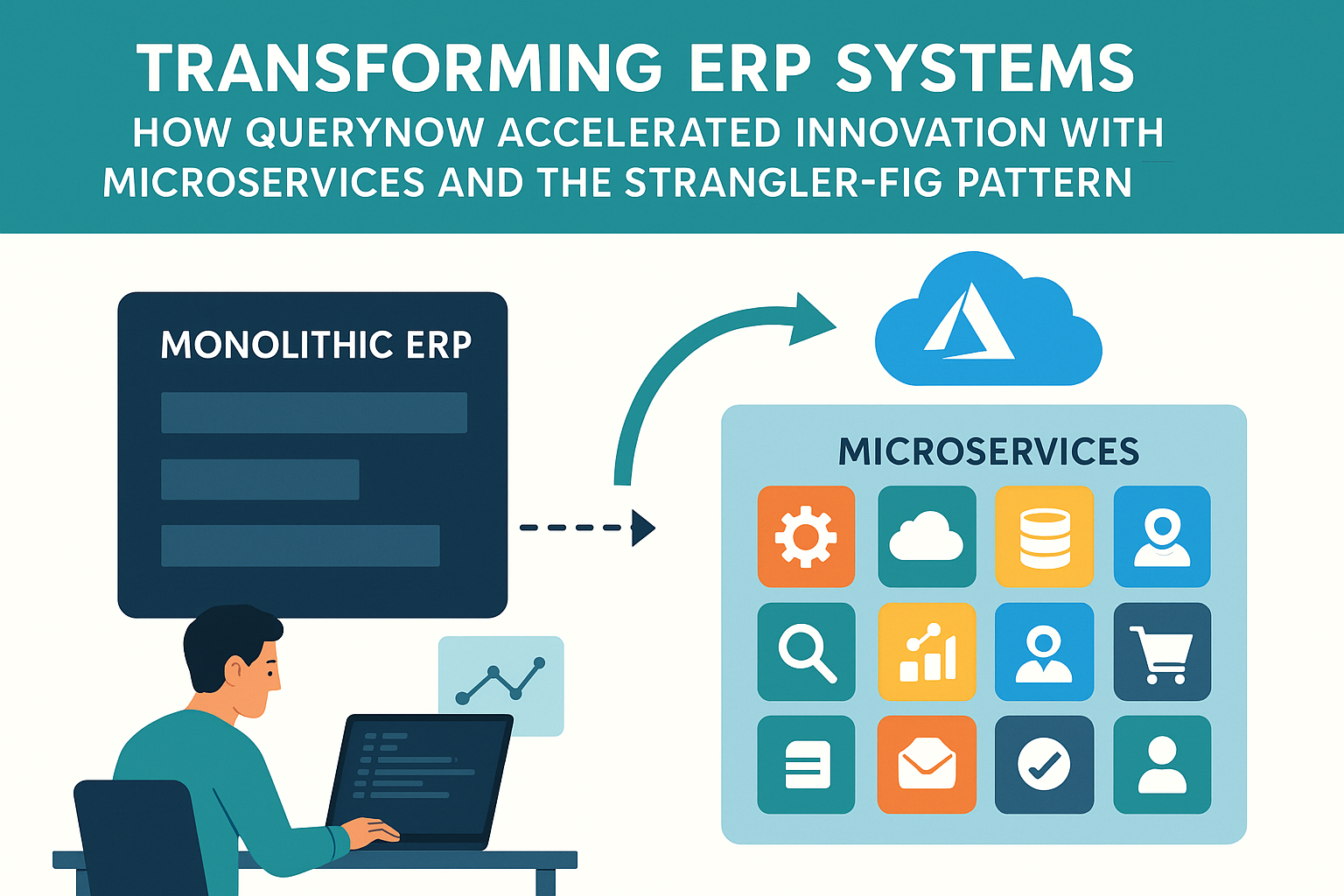
The Monolithic ERP Problem
A mid-sized manufacturer ran their entire operation on a monolithic ERP system built 15 years ago. Every business function—inventory, production scheduling, accounting, customer orders—tightly coupled in one massive application. The system worked, but it was fragile, slow to change, and impossible to extend with modern capabilities like AI or mobile access.
Adding new features required months of regression testing. Integration with external systems was a nightmare. Developers who understood the codebase were retiring. The company faced a choice: continue limping along with increasing technical debt, or embark on a multi-year complete replacement that would disrupt operations.
We showed them a third path: incremental modernization using microservices and the strangler-fig pattern.
The Strangler-Fig Strategy
The strangler-fig pattern—named after trees that gradually envelop and replace their hosts—enables modernization without risky big-bang rewrites. Instead of replacing the entire system at once, you extract functionality piece by piece, building modern microservices around the legacy core until eventually the old system can be retired.
For the manufacturer, we identified high-value, loosely-coupled components perfect for extraction: customer portal, inventory API, production scheduling, and reporting engine. Each could be modernized independently while the core ERP continued running.
Implementation Approach
Phase 1: Customer Portal (Weeks 1-6)
The customer portal was the perfect starting point—customer-facing, relatively independent, and badly in need of modernization. We built a modern web application using React and Azure App Service, connecting to the legacy ERP database initially for data.
Customers got a dramatically better experience. The development team gained confidence in the approach. And we established patterns for extracting functionality without disrupting operations.
Phase 2: Inventory API (Weeks 7-12)
Next, we extracted inventory management logic into a dedicated microservice with a clean REST API. This required more careful work since inventory touches many parts of the system. We ran old and new logic in parallel for validation before cutover.
The new service provided capabilities impossible in the monolith—real-time inventory visibility for partners, mobile warehouse apps, AI-powered stock optimization.
Phase 3: Production Scheduling (Weeks 13-20)
Production scheduling was complex business logic trapped in the monolith. We extracted it to a microservice that could integrate modern optimization algorithms impossible in the legacy system.
Planners gained tools that dramatically improved efficiency while the change remained invisible to the rest of the operation.
Phase 4: Reporting and Analytics (Weeks 21-26)
Legacy reporting was slow, inflexible, and limited. We built a modern analytics platform using Power BI and Azure Synapse, pulling data from both legacy and new systems.
Decision-makers gained real-time visibility that was never possible with the monolithic architecture.
Results and Benefits
Development Velocity:
- New feature development time: months → weeks
- Deployment frequency: quarterly → weekly for modernized components
- Regression testing time: reduced 80% for extracted services
Operational Improvements:
- Customer portal response time: 5 seconds → 200ms
- Inventory accuracy: 92% → 99.5% through real-time updates
- Production scheduling efficiency: 25% improvement through modern algorithms
Business Enablement:
- Launched mobile warehouse app (impossible with monolith)
- Integrated AI demand forecasting
- Enabled partner self-service reducing support costs
Technical Architecture
The modernized architecture leveraged Microsoft Azure:
- Azure App Service: Hosting for modern web applications
- Azure Functions: Serverless integration and event processing
- Azure API Management: Unified API gateway for microservices
- Azure SQL Database: Modern data stores for new services
- Azure Service Bus: Asynchronous messaging between services
- Azure DevOps: CI/CD pipelines for rapid deployment
Key Success Factors
Start with Business Value: We prioritized components that delivered immediate customer or operational benefits, building momentum for continued investment.
Validate Continuously: Running old and new implementations in parallel ensured accuracy before cutting over, eliminating the fear that holds back modernization.
Maintain Operational Stability: The legacy ERP continued running critical functions while modernization progressed around it—no disruption to daily operations.
Build Team Capability: Developers learned modern patterns on production projects rather than theoretical training, building organizational capability sustainably.
Lessons Learned
Embrace Temporary Complexity: During transition, maintaining both old and new systems creates complexity. Accept this as the cost of de-risking modernization.
Data Strategy Is Critical: Synchronizing data between legacy and modern systems requires careful planning and robust integration patterns.
Not Everything Must Modernize: Some stable, low-change components can remain in the monolith indefinitely. Modernization should be driven by business need, not perfectionism.
API-First Design: Building proper APIs for extracted services enables future flexibility and integration impossible with monolithic architectures.
Applicability Beyond Manufacturing
While this example involves manufacturing ERP, the strangler-fig pattern applies anywhere monolithic systems constrain innovation:
- Financial services with legacy banking platforms
- Healthcare with monolithic patient management systems
- Retail with aging e-commerce platforms
- Government with legacy case management systems
Getting Started
If your organization is trapped by a monolithic system—unable to innovate, struggling to maintain aging code, watching competitors move faster—there is a path forward that does not require years of risky rewrite projects.
Ready to modernize without the risk? Contact QueryNow for a microservices modernization assessment. We will evaluate your monolithic systems, identify high-value extraction opportunities, and provide a roadmap for incremental modernization using proven patterns.


